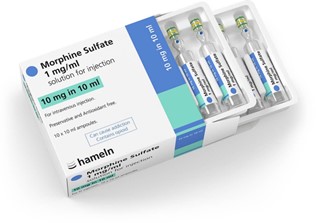The following order has been written for your client: morphine 1 mg intravenously (IV) every 2 hours as needed for pain. Which of these is true regarding this order?
If the client is still in severe pain 1 hour after the last dose, the nurse can administer an additional 1 mg of morphine.
Morphine will be given enterally.
Every two hours, the nurse will assess the need for morphine to determine if 1 mg IV should be given.
Morphine will be given every 2 hours.
The Correct Answer is C
The order states that morphine 1 mg should be given intravenously (IV) every 2 hours as needed for pain. This means that the nurse should assess the client's pain level every 2 hours and determine if 1 mg of morphine IV is needed to manage the pain.
Option A is incorrect because the order specifies that morphine should be given every 2 hours as needed, not every hour.
Option B is incorrect because the order specifies that morphine should be given intravenously (IV), not enterally.
Option D is incorrect because the order specifies that morphine should be given as needed for pain, not automatically every 2 hours.

Nursing Test Bank
Naxlex Comprehensive Predictor Exams
Related Questions
Correct Answer is D
Explanation
Certain foods can interact with medications by inhibiting or inducing cytochrome P450 (CYP) enzymes, which play a crucial role in drug metabolism ¹. This can alter the way the body processes medications and affect their efficacy and safety ¹.
Option A is not correct because not all medications are best absorbed on an empty stomach. Some medications should be taken with food to improve absorption or reduce side effects ¹.
Option B is not correct because client discomfort is not the only concern when it comes to food and medication interactions.
Option C is not correct because foods can also alter the action of medications ¹.
Correct Answer is B
Explanation
Risperidone is an atypical antipsychotic medication used to treat schizophrenia ¹. It works by changing the activity of certain natural substances in the brain ¹. A therapeutic outcome for this medication would be a decrease in symptoms of schizophrenia such as delusional thinking and audiovisual hallucinations ¹.
Option A is not correct because orthostatic hypotension and sedation are side effects of risperidone, not therapeutic outcomes ¹.
Option C is not correct because restful sleep and increased coping abilities are not specific therapeutic outcomes for risperidone in the treatment of schizophrenia.
Option D is not correct because decreased anxiety and improved dietary habits are not specific therapeutic outcomes for risperidone in the treatment of schizophrenia.

Whether you are a student looking to ace your exams or a practicing nurse seeking to enhance your expertise , our nursing education contents will empower you with the confidence and competence to make a difference in the lives of patients and become a respected leader in the healthcare field.
Visit Naxlex, invest in your future and unlock endless possibilities with our unparalleled nursing education contents today
Report Wrong Answer on the Current Question
Do you disagree with the answer? If yes, what is your expected answer? Explain.
Kindly be descriptive with the issue you are facing.
